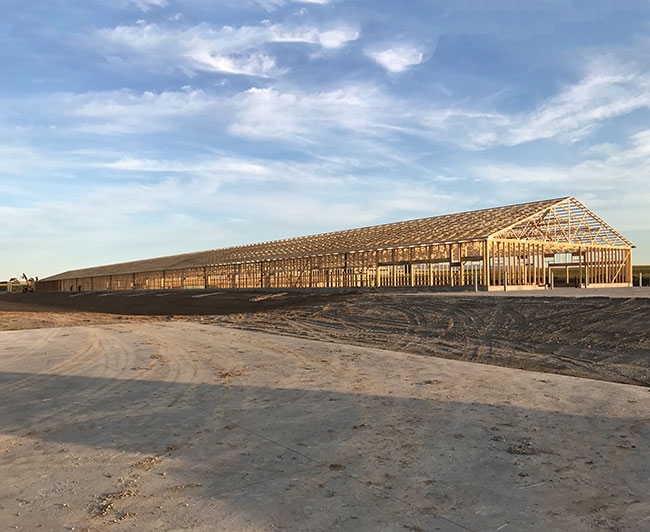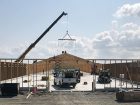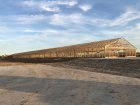
Alternative housing: Considerations to make before the build
By Madeleine Baerg
Features Health Alternative poultry housing annex Barn construction Cage free Canada Equipment Financial Planning Livestock Production Phasing Out Conventional Poultry Equipment ProductionAfter deciding on aviary or enriched, producers still face many other important questions.
 Building a new barn allows producers to customize the size, shape and layout to any system they desire. PHOTO CREDITS: Clark Ag Systems
Building a new barn allows producers to customize the size, shape and layout to any system they desire. PHOTO CREDITS: Clark Ag SystemsOnce producers make a final decision between whether they want to build cage-free or enriched housing for their flock, what next? Every farm is unique and every barn is custom designed, so decisions of all kinds still lie ahead.
The very first decision a producer needs to make is how many birds a barn is going to house. In most cases, that decision makes itself given that the majority of producers opt for maximum efficiency.
“Numbers really dictate everything: your barn size; your ventilation requirements; your housing,” says Brad Mandryk, president of Clark Ag Systems, which distributes Farmer Automatic and Tecno layer housing systems across Canada. “Do you want to maximize your current quota and bird densities? Most producers would say yes.”
Second, producers need to decide whether they plan to build new or to retrofit an existing barn. While retrofitting can often save construction dollars, investing major system upgrade money into a facility that is the wrong size or has major flaws can end up costing in the longer-run.
Building a new barn allows a producer to customize the size, shape and layout to any system they desire. Retrofitting an old barn is more complicated and, in certain cases, existing infrastructure will dictate what kind of system and numbers are possible.
“It’s all about the space you’ve got,” says David Lefebvre, professional engineer and director of operations for Ferme St-Ours Inc. “In an existing building you can’t do whatever you want. An aviary system needs a precise building width and usually needs a lot of ceiling height. There are many different aviary systems and some can fit in a lower-roofed building but it’s not the best.”
Equipment provider
Farmers also need to determine which company to partner with for the system construction. Various companies approach the design process differently: Some design a system from start to finish to make the process easy for producers, while others ask for significant producer input along the way.
“Ultimately, producers have significant control on the very critical decisions they have to make. Although the standards of code of practice have to be met with the way a barn is laid out, there are lots of big decisions,” says Amy Carter, general manager of Clark Ag Systems.
“While they very much ask for our expertise to put together a design that works, it’s important that farmers look at the different systems that are out there, consider the different management techniques and go out and visit other farmers. While they look to us for insight, most farmers are very engaged and want to be part of the process.”
Regardless of company, every installation is customized to a producer’s needs. “Every company that sells cages, we’ll all customize equipment to a producer’s needs. If it’s in an existing facility, we’ll work with that. If it’s in a new facility, we’ll show them how to maximize space. There’s never two quotes that are the same,” says Ron Wardrop, Canadian sales manager with Big Dutchman.
“In Finland, they prefer wooden nests because (they think) birds like wood more than metal,” says Andreas Moors, area sales manager for Hellmann Poultry. “For that market, we started to supply wood nests. As a middle-sized company with short decision paths, we can offer a flexible production that allows us to work with a customer if they have unique requests, so long as our design team says the request is not interfering with overall quality or design.”
In certain cases, choosing one company’s product over another may come down to what you’ve already got in place. For example, some parts of Hellman Poultry’s cage equipment (motors, drive units, feed corners, control units and sometimes other components) can be re-used within a Hellmann’s aviary system, Moors says. That can translate to significant cost savings. If you currently have equipment in decent repair, it’s a good idea to check with that manufacturer first to see if repurposing might be possible.
Barn design
The design process starts with a calculation of space based on the number of birds desired. Typically, the floor space, ceiling height and flock size determine the number of tiers in an enriched system and the layout in an aviary. Because in certain cases a producer may have a choice of how many tiers to install, keep in mind that managing a single tier is easier than managing multiple tiers, experts say.
In most cases, manure is not completely removed from an aviary’s aisle-ways until the hens are retired, though some producers are now opting for deep pit systems to allow manure to drop below hen level. Because manure increases both moisture and dust, managing air moisture quality must be a major priority.
Ventilation also plays a huge role in how any barn is designed. From simple to complex, there are many concepts. While ventilation is critical in any laying barn, Lefebvre recommends investing in a heat exchanger for an aviary.
“Layers that are comfortable will lay you eggs. If you give them a good environment, they will lay more eggs. It’s not an obligation to install but it’s a good thing: an investment that offers payback. If you install a heat exchange system, you’re going to be able to ventilate more for the same energy cost, giving you better air condition and drier manure.”
For maximum ventilation, Lefebvre recommends tunnel ventilation that ventilates a barn from front to back and generates higher air speed in summer.
And, he points out, this kind of ventilation system allows easier trapping of light from outside.
Research and innovation
Researchers and equipment companies continue to work to improve how birds are housed in both enriched and cage-free systems. Because both are fairly new, experts are making great strides forward.
“There is a lot of research going on at the university level right now around what is the best environment for animal welfare. The (current designs for both aviary and enriched systems) have come a long way from where they used to be,” Clark’s Mandryk says.
Perches are a case in point. Today, they come in round, square and mushroom-style and can be made from various materials. At this point, decisions will be based on a producer’s preferences and a poultry equipment dealer’s recommendations. However, researchers, including some at the University of Guelph, continue to test different perch designs and may soon offer additional insights.
Lighting needs to be a key priority in all systems. In multi-tiered enriched housing systems, a top tier can get adequate light from aisle/ceiling mounted light sources. However, lower tiers will suffer from heavy shadowing.
As Big Dutchman’s Wardrop explains, the downsides of inadequate lighting include a harder time adjusting to the system, lower feed intake and poorer nest acceptance. Luckily, LED technology allows lighting to be small and cool enough that it can be mounted right inside cages themselves.
“We’ve seen a real spike in in-system lighting versus when enriched housing first came out,” Carter says. “That came down to testing. Enriched systems are a lot taller, a lot deeper and have a lot more birds in a colony than a conventional cage.
“That offers up different challenges because you want to be very uniform in your lighting. Your lighting program is very important for both the birds’ behaviour and their productivity.”
While the new code of practice outlines minimum nesting space requirements, producers may benefit from additional nesting space. “Something researchers are really looking at right now is the even distribution of birds laying eggs. Is it better to have just the required number of nesting spaces?” Carter says.
“We don’t necessarily go by the code on minimum nest space requirements. We tend to suggest increasing nest space to provide uniformity and distribution of eggs which minimizes egg undergrads.”
Sorting through options
In any aviary system design, Lefebvre recommends looking closely at how all the systems are managed. “In an aviary system, there are as many designs, as you can imagine, and they are all different. Even a single company can propose many kinds of systems.
“Ask, ‘Where is the feed? Where are the water lines? Where are the nests? How easy would it be for a bird to lay in that nest?’ I don’t think multiple short perches or fewer long perches make a big difference. But it is important to ask, ‘Is it easy for birds to jump from perches evenly from one side to the other?’”
He recommends choosing a system where you can easily see and touch all the components and where you can see the birds everywhere in the system.
Given that certain companies used to offer enrichable conventional cages, some farmers wonder if they can start with enriched housing and convert it to cage-free when necessary by simply removing the doors and installing enrichments like exterior perches. Though this transition may theoretically be possible with certain systems, Wardrop recommends against it.
The problem, he explains, is that an enriched system’s aisles are typically around 40-inches wide, whereas a cage-free system requires aisles that are 60-inches across. “If you take the doors off and have a 40 inch aisle, (a cage-free system) is just never going to run really well,” he says. “We try to talk producers out of doing it.”
Carter, on the other hand, says meeting customers’ requests for flexibility is possible. “(We) are seeing an increase in producers wanting to have the flexibility in their barn design to convert from an enriched cage system to an aviary style system. With effective planning that takes into consideration the conversion from enriched to aviary, we see that productivity, welfare and management are not compromised.”
Most importantly and at every stage in the process, remember to ask questions and make open communication a priority.
“We’re seeing a lot more really good interaction between egg graders and producers and equipment dealers. We’re seeing that communication process ramp up dramatically,” Mandryk says. “There’s a real partnership approach between all the parties and that’s really good.”
Print this page

